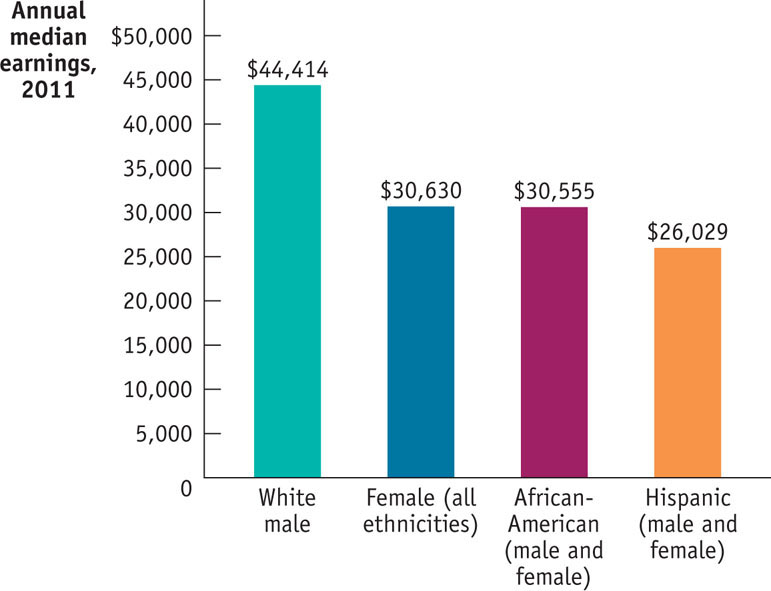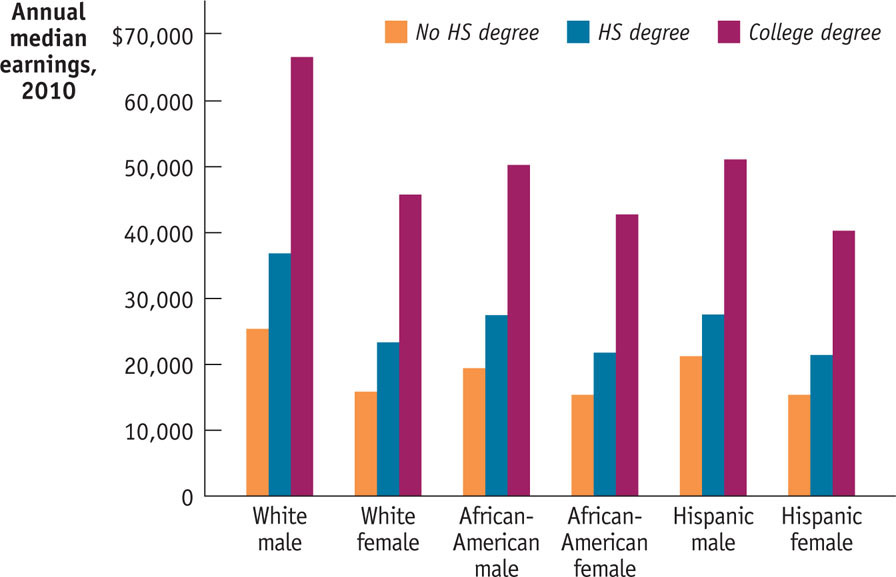1.2 41Marginal Productivity Theory

WHAT YOU WILL LEARN
 Labor market applications of the marginal productivity theory of income distribution
Labor market applications of the marginal productivity theory of income distribution
 Sources of wage disparities and the role of discrimination
Sources of wage disparities and the role of discrimination
In the previous module we introduced the factor distribution of income. In this module, we will go a step further and explain how the marginal productivity theory of income distribution helps to explain how income is divided among factors of production in an economy. We will consider how the markets for factors of production are broken down. There are different markets for different types of factors. For example, there are different labor markets for different types of labor, such as for computer programmers, pastry chefs, and economists. Then, we look at the marginal productivity theory of income distribution and the extent to which it explains wage disparities between workers.
The Marginal Productivity Theory of Income Distribution
According to the marginal productivity theory of income distribution, every factor of production is paid the equilibrium value of its marginal product.
The equilibrium value of the marginal product of a factor is the additional value produced by the last unit of that factor employed in the factor market as a whole.
The marginal productivity theory of income distribution sums up what we have learned about payments to factors when goods markets and factor markets are perfectly competitive. According to this theory, each factor is paid the value of the output generated by the last unit of that factor employed in the factor market as a whole—
To understand why the marginal productivity theory of income distribution is important, look back at Figure 40-1, which shows the factor distribution of income in the United States in 2012, and ask yourself this question: who or what determined that labor would get 71% of total U.S. income? Why not 90% or 50%?
FIGURE41-1Median Earnings by Gender and Ethnicity, 2011

The answer, according to this theory, is that the division of income among the economy’s factors of production isn’t arbitrary: in the economy-
So far we have treated factor markets as if every unit of each factor were identical. That is, as if all land were identical, all labor were identical, and all capital were identical. But in reality factors differ considerably with respect to productivity. For instance, land resources differ in their ability to produce crops and workers have different skills and abilities.
Rather than thinking of one land market for all land resources in an economy, and similarly one capital market and one labor market, we can instead think of different markets for different types of land, physical capital, human capital, and labor. For example, the market for computer programmers is different from the market for pastry chefs.
When we consider that there are separate factor markets for different types of factors, the marginal productivity theory of income distribution still holds. That is, when the labor market for computer programmers is in equilibrium, the wage rate earned by all computer programmers is equal to the market’s equilibrium value of the marginal product—
The marginal productivity theory can explain the distribution of income among different types of land, labor, physical capital, and human capital as well as the distribution of income among the factors of production. Next we look more closely at the distribution of income between different types of labor and the extent to which the marginal productivity theory of income distribution explains differences in workers’ wages.
HELP WANTED!
Hamill Manufacturing of Pennsylvania makes precision components for military helicopters and nuclear submarines. Their highly skilled senior machinists are well paid compared to other workers in manufacturing, earning nearly $70,000 in 2011, excluding benefits. Like most skilled machinists in the United States, Hamill’s machinists are very productive: according to the U.S. Census Annual Survey of Manufacturers, in 2010 the average skilled machinist generated approximately $137,000 in value added.
But there is a $67,000 difference between the salary paid to Hamill machinists and the value added they generate. Does this mean that the marginal productivity theory of income distribution doesn’t hold? Doesn’t the theory imply that machinists should be paid $137,000, the average value added that each one generates?

The answer is no, for two reasons. First, the $137,000 figure is averaged over all machinists currently employed. The theory says that machinists will be paid the value of the marginal product of the last machinist hired, and due to diminishing returns to labor, that value will be lower than the average over all machinists currently employed. Second, a worker’s equilibrium wage rate includes other costs, such as employee benefits, that have to be added to the $70,000 salary. The marginal productivity theory of income distribution says that workers are paid a wage rate, including all benefits, equal to the value of the marginal product.
You can see all these costs are present at Hamill. There the machinists have good benefits and job security, which add to their salary. Including these benefits, machinists’ total compensation will be equal to the value of the marginal product of the last machinist employed.
In Hamill’s case, there is yet another factor that explains the $67,000 gap: there are not enough machinists at the current wage rate. Although the company increased the number of employees from 85 in 2004 to 125 in 2011, they would like to hire more.
Why doesn’t Hamill raise its wages in order to attract more skilled machinists? The problem is that the work they do is so specialized that it is hard to hire from the outside, even when the company raises wages as an inducement. To address this problem, Hamill has spent a significant amount of money training each new hire, approximately $125,000 plus the cost of benefits per trainee. In the end, it does appear that the marginal productivity theory of income distribution holds.
Is the Marginal Productivity Theory of Income Distribution Really True?
Although the marginal productivity theory of income distribution is a well-
First, in the real world we see large disparities in income between factors of production that, in the eyes of some observers, should receive the same payment. Perhaps the most conspicuous examples in the United States are the large differences in the average wages between women and men and among various racial and ethnic groups. Do these wage differences really reflect differences in marginal productivity, or is something else going on?
Second, many people wrongly believe that the marginal productivity theory of income distribution gives a moral justification for the distribution of income, implying that the existing distribution is fair and appropriate. This misconception sometimes leads other people, who believe that the current distribution of income is unfair, to reject marginal productivity theory.
To address these controversies, we’ll start by looking at income disparities across gender and ethnic groups. Then we’ll ask what factors might account for these disparities and whether these explanations are consistent with the marginal productivity theory of income distribution.
Wage Disparities in Practice
Wage rates in the United States cover a very wide range. In 2012, hundreds of thousands of workers received the legal federal minimum of $7.25 per hour. At the other extreme, the chief executives of several companies were paid more than $100 million, which works out to $20,000 per hour even if they worked 100-
A particular source of concern is the existence of systematic wage differences across gender and ethnicity. Figure 41-1 compares annual median earnings in 2011 of workers age 25 or older classified by gender and ethnicity. As a group, White males had the highest earnings. Other data show that women (averaging across all ethnicities) earned only about 69% as much; African-
We are a nation founded on the belief that all men are created equal—
Marginal Productivity and Wage Inequality
A large part of the observed inequality in wages can be explained by considerations that are consistent with the marginal productivity theory of income distribution. In particular, there are three well-
Compensating differentials are wage differences across jobs that reflect the fact that some jobs are less pleasant than others.
First is the existence of compensating differentials: across different types of jobs, wages are often higher or lower depending on how attractive or unattractive the job is. Workers with unpleasant or dangerous jobs demand a higher wage in comparison to workers with jobs that require the same skill and effort but lack the unpleasant or dangerous qualities. For example, truckers who haul hazardous loads are paid more than truckers who haul non-
A second reason for wage inequality that is clearly consistent with marginal productivity theory is differences in talent. People differ in their abilities: a higher-
A third and very important reason for wage differences is differences in the quantity of human capital. Recall that human capital—
The most direct way to see the effect of human capital on wages is to look at the relationship between educational levels and earnings. Figure 41-2 shows earnings differentials by gender, ethnicity, and three educational levels for people age 25 or older in 2010. As you can see, regardless of gender or ethnicity, higher education is associated with higher median earnings. For example, in 2010 White females with 9 to 12 years of schooling but without a high school diploma had median earnings 32% less than those with a high school diploma and 65% less than those with a college degree—
FIGURE41-2Earnings Differentials by Education, Gender, and Ethnicity, 2010

Because even now men typically have had more years of education than women and Whites more years than non-
It’s also important to realize that formal education is not the only source of human capital; on-
But it’s also important to emphasize that earnings differences arising from differences in human capital are not necessarily “fair.” A society in which non-
Still, many observers think that actual wage differentials cannot be entirely explained by compensating differentials, differences in talent, and differences in human capital. They believe that market power, efficiency wages, and discrimination also play an important role. We will examine these forces next.
Market Power
The marginal productivity theory of income distribution is based on the assumption that factor markets are perfectly competitive. In such markets we can expect workers to be paid the equilibrium value of their marginal product, regardless of who they are. But how valid is this assumption?
We studied markets that are not perfectly competitive; now let’s touch briefly on the ways in which labor markets may deviate from the competitive assumption.
Unions are organizations of workers that try to raise wages and improve working conditions for their members by bargaining collectively with employers.
One undoubted source of differences in wages between otherwise similar workers is the role of unions—organizations that try to raise wages and improve working conditions for their members. Labor unions, when they are successful, replace one-

Just as workers can sometimes organize to extract higher wages than they would otherwise receive, employers can sometimes organize to pay lower wages than would result from competition. For example, health care workers—
How much does collective action, either by workers or by employers, affect wages in the modern United States? Several decades ago, when around 30% of American workers were union members, unions probably had a significant upward effect on wages. Today, however, most economists think unions exert a fairly minor influence. Union membership in the United States is relatively limited: in 2012, only 6.6% of the employees of private businesses were represented by unions.
Efficiency Wages
A second source of wage inequality is the phenomenon of efficiency wages—a type of incentive scheme used by employers to motivate workers to work hard and to reduce turnover. Suppose a worker performs a job that is extremely important but that the employer can observe how well the job is being performed only at infrequent intervals—
So a worker who happens to be observed performing poorly and is therefore fired is now worse off for having to accept a lower paying job. The threat of losing a job that pays a premium motivates the worker to perform well and avoid being fired. Likewise, paying a premium also reduces worker turnover—
According to the efficiency-
The efficiency-
As a result, two workers with exactly the same profile—
Discrimination
It is a real and ugly fact that throughout history there has been discrimination against workers who are considered to be of the wrong race, ethnicity, gender, or other characteristics. How does this fit into our economic models?
The main insight economic analysis offers is that discrimination is not a natural consequence of market competition. On the contrary, market forces tend to work against discrimination. To see why, consider the incentives that would exist if social convention dictated that women be paid, say, 30% less than men with equivalent qualifications and experience. A company whose management was itself unbiased would then be able to reduce its costs by hiring women rather than men—
But if market competition works against discrimination, how is it that so much discrimination has taken place? The answer is twofold. First, when labor markets don’t work well, employers may have the ability to discriminate without hurting their profits. For example, market interferences (such as unions or minimum-

Second, discrimination has sometimes been institutionalized in government policy. This institutionalization of discrimination has made it easier to maintain it against market pressure, and historically it is the form that discrimination has typically taken. For example, at one time in the United States, African-
So Does Marginal Productivity Theory Work?
The main conclusion you should draw from this discussion is that the marginal productivity theory of income distribution is not a perfect description of how factor incomes are determined but that it works pretty well. The deviations are important. But, by and large, in a modern economy with well-
It’s important to emphasize, once again, that this does not mean that the factor distribution of income is morally justified.
41
Solutions appear at the back of the book.
Check Your Understanding
1. Assess each of the following statements. Do you think they are true, false, or ambiguous? Explain.
-
a. The marginal productivity theory of income distribution is inconsistent with the presence of income disparities associated with gender, race, or ethnicity.
False. Income disparities associated with gender, race, and ethnicity can be explained by the marginal productivity theory of income distribution, provided that differences in marginal productivity across people are correlated with gender, race, or ethnicity. One possible source for such correlation is past discrimination. Such discrimination can lower individuals’ marginal productivity by, for example, preventing them from acquiring the human capital that would raise their productivity. Another possible source of the correlation is differences in work experience that are associated with gender, race, or ethnicity. For example, in jobs for which work experience or length of tenure is important, women may earn lower wages because on average more women than men take child-care-related absences from work. -
b. Companies that engage in workplace discrimination but whose competitors do not are likely to earn less profit as a result of their actions.
True. Companies that discriminate when their competitors do not are likely to hire less able workers because they discriminate against more able workers who are considered to be of the wrong gender, race, ethnicity, or other characteristic. And with less able workers, such companies are likely to earn less profit than their competitors who don’t discriminate. -
c. Workers who are paid less because they have less experience are not the victims of discrimination.
Ambiguous. In general, workers who are paid less because they have less experience may or may not be the victims of discrimination. The answer depends on the reason for the lack of experience. If workers have less experience because they are young or have chosen to do something else rather than gain experience, then they are not victims of discrimination as long as the lower earnings are commensurate with the lower level of experience (as opposed, for example, to earning a lot less while having just a little less experience). But if workers lack experience because previous job discrimination prevented them from gaining experience, then they are indeed victims of discrimination when they are paid less.
Multiple-
Question
1. Which group of U.S. workers had the highest median earnings in 2011?
| A. |
| B. |
| C. |
| D. |
| E. |
Question
2. Which of the following sources of wage differences is/are consistent with the marginal productivity theory of income distribution?
I. talent
II. discrimination
III. efficiency wages
| A. |
| B. |
| C. |
| D. |
| E. |
Question
3. Compensating differentials mean that which of the following leads to higher wages for some jobs?
| A. |
| B. |
| C. |
| D. |
| E. |
Question
4. Which of the following is a result in the efficiency-
| A. |
| B. |
| C. |
| D. |
| E. |
Question
5. Which of the following statements regarding the marginal productivity theory of income distribution is correct?
| A. |
| B. |
| C. |
| D. |
| E. |
Critical-
List three different economic concepts that explain wage differences when the marginal productivity theory of income distribution does not. Explain each.
- Market power—firms with market power can organize to pay lower wages than would result in a perfectly competitive labor market. Monopsonies pay less than the value of the marginal product of labor. And unions can organize to demand higher wages than would result in a perfectly competitive labor market.
- Efficiency wages—some firms pay high wages to boost worker performance and encourage loyalty.
- Discrimination—some firms pay workers differently solely on the basis of worker characteristics that do not affect marginal productivity.
GETTING MARGINAL PRODUCTIVITY THEORY RIGHT
 According to the marginal productivity theory, are workers paid a wage equal to the value of their own marginal product of labor?
According to the marginal productivity theory, are workers paid a wage equal to the value of their own marginal product of labor?
 No they are not. Remember what the marginal productivity theory of income distribution says: all units of a factor get paid the factor’s equilibrium value of the marginal product —the additional value produced by the last unit of the factor employed. a common source of error is to forget that the relevant value of the marginal product is the equilibrium value, not the value of the marginal products you calculate on the way to equilibrium. For an example, look back at Table 40-2. There, the first worker has a value of the marginal product of $380. It’s tempting to conclude that because that worker has a value of the marginal product of $380, he or she is paid $380 in equilibrium. But, that’s not the case. If the equilibrium value of the marginal product in the labor market is equal to $200, then all workers receive $200.
No they are not. Remember what the marginal productivity theory of income distribution says: all units of a factor get paid the factor’s equilibrium value of the marginal product —the additional value produced by the last unit of the factor employed. a common source of error is to forget that the relevant value of the marginal product is the equilibrium value, not the value of the marginal products you calculate on the way to equilibrium. For an example, look back at Table 40-2. There, the first worker has a value of the marginal product of $380. It’s tempting to conclude that because that worker has a value of the marginal product of $380, he or she is paid $380 in equilibrium. But, that’s not the case. If the equilibrium value of the marginal product in the labor market is equal to $200, then all workers receive $200.
To learn more, see pages 432–
